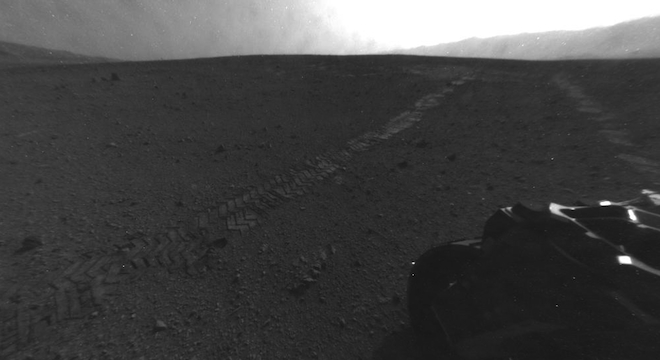NASA’s Mars Curiosity Rover has made more than one small step on the surface of the Red Planet: The rover has driven a total of over 83 feet in three separate test drives since it first touched down on Mars on August 6.
The latest drive was the furthest yet, at 52 feet on Tuesday, NASA reported.
NASA on Wednesday released new images of the marks left by the rover from the most recent drive and the previous ones, including a new annotated image showing the Morse code message left behind by a single line of pattern molded into the rover’s treads on each of the six wheels, which spells out “JPL,” the initials of NASA’s Jet Propulsion Laboratory, the division in charge of the mission.
See the Morse code pattern highlighted in the Martian sand below, via NASA:

As an homage, adored mohawked NASA flight engineer Bobak Ferdowski updated his hairstyle to include the Morse code message:

Aside from leaving an unmistakable piece of human graffiti on the Red Planet’s dusty terrain, the Morse code actually serves a useful scientific purpose for the mission, giving scientists the ability to more accurately measure its driving distances and proximity to other features using “visual odometry” software onboard. This is helpful because in looser, more granular or varied terrain, the rover could slip and get stuck.
Another black and white “fisheye” shot after the first test drive on August 22, clearly reveals the distinction between the single line of Morse code pattern and the zig-zag pattern that makes up the remainder of each rover wheel’s tread.

This one shows the tracks to the side of the 7-foot-long robotic arm (retracted in the image):

“The purpose of the pattern is to create features in the terrain that can be used to visually measure the precise distance between drives,” said Matt Heverly, the lead rover driver for Curiosity, in a statement posted on NASA’s JPL website on Wednesday.
Here’s another black and white shot showing Martian soil on the rover’s middle and back wheels on its right side:

Now, the six-wheeled, car-sized rover is going even further, heading in the direction of an area nicknamed “Glenelg,” located approximately 1,300 feet, or a quarter-mile, away from its present location. NASA chose this site because it’s one where three different types of terrain meet, giving scientists the ability to see more diversity in the planet’s geologic formations.
At a top speed of less than a tenth-of a mile-per-hour (1.6 inches per second), it should take the rover a “few weeks” to get to the site.
Specifically, NASA is interested in looking at a light-colored expanse that shows up in satellite thermal imagery and may have been cemented through natural processes, rather than formed by volcanic activity, as a scientist on the mission recently told the CBC.
Once it arrives, NASA hopes to find a suitable rockbed on which to use the rover’s industrial strength drill, located at the end of its robotic, to sample the Martian geology.
Along the way, the Curiosity rover will continue collecting arresting images of its surrounds using its twin mast-mounted cameras, or Mastcam, which has already produced the most detailed views of the Martian surface ever captured.
NASA also promised a new composite image, or mosaic, as well as 3D views of the rover’s surrounds.
Until it delivers, Earthlings can enjoy looking around Mars thanks to an incredible new full-color interactive panorama created by Danish commercial photographer Hans Nyberg on his website Panoramas.dk, using previously released Mars Curiosity composite imagery.
Glenelg isn’t the Curiosity rover’s ultimate destination, just a detour: Instead, scientists plan to drive the rover toward and partially up Mount Sharp, a 3.4-mile-high mountain inside the area containing the landing site, Gale Crater, a 96-mile wide impact site that may have retained liquid water at some point during Martian history.
The Mars Curiosity mission, also known as the Mars Science Laboratory, is scheduled for full-service operations over the next 23 months, but the rover’s lifetime will likely extend well beyond that, powered as it is by a nuclear battery. The rover was designed to search Mars for evidence that it ever had, at any point in its history, conditions of habitability, or the necessary ingredients — water, a consistent nontoxic atmosphere — capable of supporting life.






